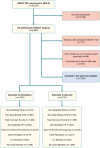Legacy benefits of blood pressure treatment on cardiovascular events are primarily mediated by improved blood pressure variability: the ASCOT trial
- PMID: 38291599
- PMCID: PMC10984564
- DOI: 10.1093/eurheartj/ehad814
Legacy benefits of blood pressure treatment on cardiovascular events are primarily mediated by improved blood pressure variability: the ASCOT trial
Abstract
Background and aims: Visit-to-visit systolic blood pressure variability (BPV) is an important predictor of cardiovascular (CV) outcomes. The long-term effect of a period of blood pressure (BP) control, but with differential BPV, is uncertain. Morbidity and mortality follow-up of UK participants in the Anglo-Scandinavian Cardiac Outcomes Trial-Blood Pressure-Lowering Arm has been extended for up to 21 years to determine the CV impact of mean systolic blood pressure (SBP) control and BPV during the trial, and amongst those allocated to amlodipine- and atenolol-based treatment.
Methods: Eight thousand five hundred and eighty hypertensive participants (4305 assigned to amlodipine ± perindopril-based and 4275 to atenolol ± diuretic-based treatment during the in-trial period (median 5.5 years) were followed for up to 21 years (median 17.4 years), using linked hospital and mortality records. A subgroup of participants (n = 2156) was followed up 6 years after the trial closure with a self-administered questionnaire and a clinic visit. In-trial mean SBP and standard deviation of visit-to-visit SBP as a measure of BPV, were measured using >100 000 BP measurements. Cox proportional hazard models were used to estimate the risk [hazard ratios (HRs)], associated with (i) mean with SBP and BPV during the in-trial period, for the CV endpoints occurring after the end of the trial and (ii) randomly assigned treatment to events following randomization, for the first occurrence of pre-specified CV outcomes.
Results: Using BP data from the in-trial period, in the post-trial period, although mean SBP was a predictor of CV outcomes {HR per 10 mmHg, 1.14 [95% confidence interval (CI) 1.10-1.17], P < .001}, systolic BPV independent of mean SBP was a strong predictor of CV events [HR per 5 mmHg 1.22 (95% CI 1.18-1.26), P < .001] and predicted events even in participants with well-controlled BP. During 21-year follow-up, those on amlodipine-based compared with atenolol-based in-trial treatment had significantly reduced risk of stroke [HR 0.82 (95% CI 0.72-0.93), P = .003], total CV events [HR 0.93 (95% CI 0.88-0.98), P = .008], total coronary events [HR 0.92 (95% CI 0.86-0.99), P = .024], and atrial fibrillation [HR 0.91 (95% CI 0.83-0.99), P = .030], with weaker evidence of a difference in CV mortality [HR 0.91 (95% CI 0.82-1.01), P = .073]. There was no significant difference in the incidence of non-fatal myocardial infarction and fatal coronary heart disease, heart failure, and all-cause mortality.
Conclusions: Systolic BPV is a strong predictor of CV outcome, even in those with controlled SBP. The long-term benefits of amlodipine-based treatment compared with atenolol-based treatment in reducing CV events appear to be primarily mediated by an effect on systolic BPV during the trial period.
Keywords: ASCOT; Blood pressure variability; Cardiovascular events.
© The Author(s) 2024. Published by Oxford University Press on behalf of the European Society of Cardiology.
Figures




References
-
- Dahlöf B, Sever PS, Poulter NR, Wedel H, Beevers DG, Caulfield M, et al. Prevention of cardiovascular events with an antihypertensive regimen of amlodipine adding perindopril as required versus atenolol adding bendroflumethiazide as required, in the Anglo-Scandinavian Cardiac Outcomes Trial-Blood Pressure Lowering Arm (ASCOT-BPLA): a multicentre randomised controlled trial. Lancet 2005;366:895–906. 10.1016/S0140-6736(05)67185-1 - DOI - PubMed
-
- Poulter NR, Wedel H, Dahlöf B, Sever PS, Beevers DG, Caulfield M, et al. Role of blood pressure and other variables in the differential cardiovascular event rates noted in the Anglo-Scandinavian Cardiac Outcomes Trial-Blood Pressure Lowering Arm (ASCOT-BPLA). Lancet 2005;366:907–13. 10.1016/S0140-6736(05)67186-3 - DOI - PubMed
MeSH terms
Substances
Grants and funding
LinkOut - more resources
Full Text Sources
Medical

